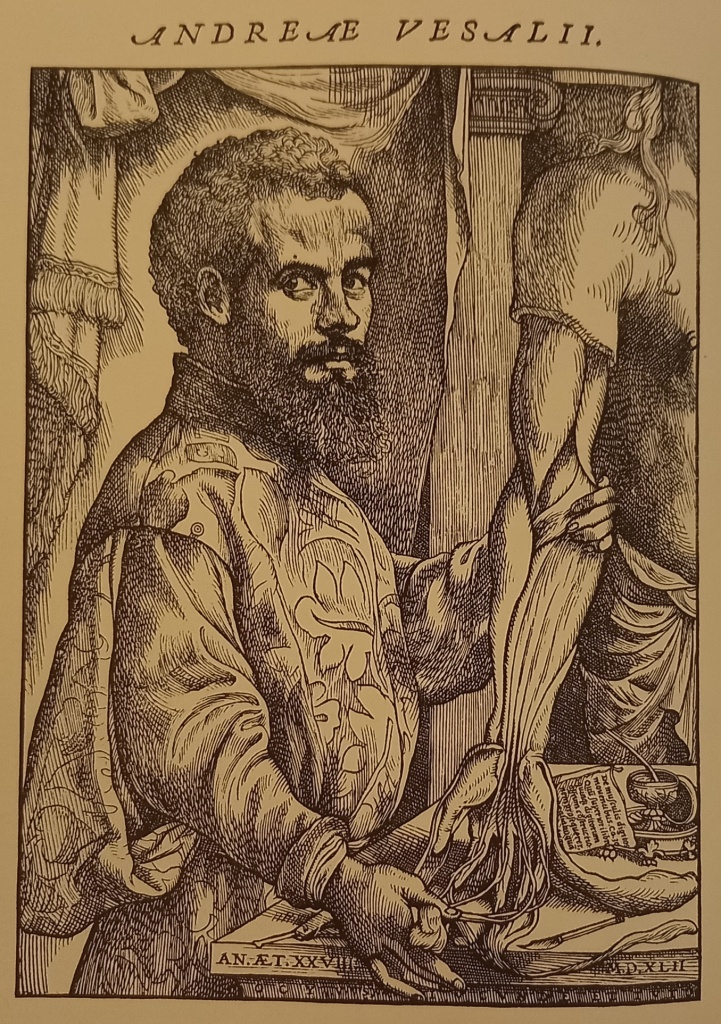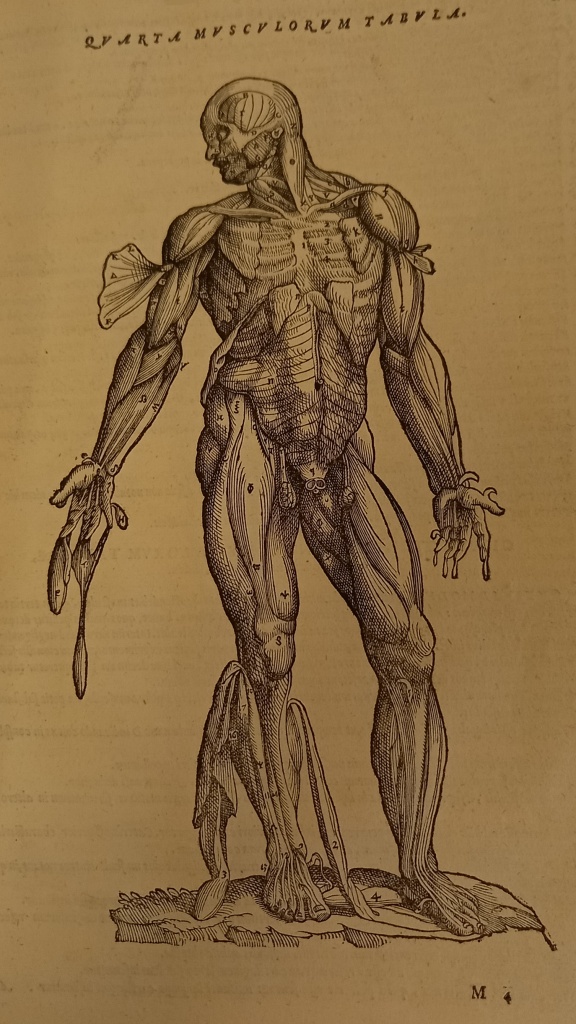Andreas Vesalius (1514-1564) was a physician who published the first complete anatomy textbook: De humani corporis fabrica libri septem (the Fabrica), which contained detailed illustrations of the human body. Prior to Vesalius, it was the work of physician Galen which had been viewed as the main source of anatomical knowledge. However, Galen’s work was based on the dissection of non-human animals, and this led to Vesalius (who conducted dissections of humans) to find errors in Galen’s work. [1]
Vesalius identified more than 200 errors in Galen’s work, including those relating to bone structure, muscle structure, and the number of bones that make up the sternum. [2] Vesalius had not always disagreed with Galen, and had become more critical of Galen over time. This complexity can be explored in relation to Abu Bakr al-Razi (also known as Rhazes, 865-925), an influential Arab physician who wrote medical books including Al-Hawi fi al-Tibb. [3] Vesalius’ opinions on both Galen’s and Rhazes’ work changed gradually. [4]
Looking at the beginning of Vesalius’ career, his first book was a paraphrased version of the ninth book of Rhazes’ Liber ad Almansorem, which was one of Rhazes’ most influential works. This reflected Vesalius’ more negative view of Rhazes’ writings at the time, and contained Vesalius’ corrections, and notes emphasising support of Galen. Vesalius was able to put together this paraphrasis due to translation of the Liber ad Almansorem into Latin in the 12th century.
It is important to acknowledge that, whilst the Liber ad Almansorem was significant in its own right, European universities also made use of Vesalius’ paraphrased version. Whilst a translated version was required so that people could understand the text, the fact that Vesalius’ paraphrased version was used could indicate a lack of trust by many Europeans at the time in Arabic science and medicine. Vesalius himself also displayed this lack of trust through his criticisms of Rhazes. This general feeling of distrust was demonstrated in events such as in 1563, when the London College of Physicians changed focus of examination questions solely onto Galen’s ‘version’ of anatomy, and in 1565, when the University of Alcalá de Henares removed Avicenna (another Arab physician) from their curriculum. [4]
However, later in Vesalius’ career, there was a shift, where he started to find that his own findings had more agreements with Rhazes and disagreements with Galen – and he demonstrated this in the Fabrica. [4] Vesalius’ criticisms of Galen were significant because Galen had previously been viewed by many as an infallible figure in the field of anatomy. Vesalius’ work also demonstrated the importance of making direct observations in science – in this case, examining humans in investigations of human anatomy. [5] It could be argued that this helped to liberate those studying natural philosophy and medicine at the time, as it showed they did not always have to rely on the knowledge of the ancients, and could make observations for themselves.
Rhazes was also a critic of Galen, and these criticisms featured in his book Liber Continens (translated into Latin in 1279). [4, 6] Furthermore, criticisms of Galen still featured in the Latin translation, despite some changes being made. [4] Therefore, this demonstrates that Vesalius was not the first to find fault with Galen’s work.
It can also be noted that Vesalius was not the first to use dissections to provide evidence against Galen’s theories. In the 13th century, Ibn al-Nafis proposed a new account of how blood circulates the body, particularly how it moves from the right to the left ventricle in the heart, before it is pumped around the rest of the body. Galen had proposed that blood moved across the septum, however al-Nafis said that the septum was impenetrable, and that blood moves from the right to the left ventricle via the lungs. He reached this theory using evidence based on dissections. [7]
Therefore, whilst Vesalius is a well-known name in European teachings of the history of science, one should be aware of the work of ancient Islamic physicians such as Rhazes and Ibn al-Nafis, including how they also criticised Galen.
Blog post researched, written and produced by a HPS student.
Pictures
[a] STORE 225.18 OS. Andreae Vesalij Bruxellensis inuictissimi Caroli V. Imp. medici de humani corporis fabrica libri septem : cum indice rerum & uerborum memorabilium locupletissimo.
[b] STORE 80:8. Andreae Vesalii … De humani corporis fabrica libri septem.
References
[1] Florkin, M. (2022, May 28). Andreas Vesalius. Retrieved from Britannica: https://www.britannica.com/biography/Andreas-Vesalius
[2] Markatos, K., Chytas, D., Tsakotos, G., Karamanou, M., Piagkou, M., & Johnson, E. (2018). Vesalius criticism on Galen’s musculoskeletal anatomy. Acta Chirurgica Belgica, 267-271.
[3] Samir S. Amr, A. T. (2007). Abu Bakr Muhammad Ibn Zakariya Al Razi (Rhazes): Philosopher, Physician and Alchemist. Annals of Saudi Medicine, 305-307.
[4] Compier, A. H. (2012). Rhazes in the Renaissance of Andreas Vesalius. Medical History, 3-25.
[5] Lanska, D. (2015). The evolution of Vesalius’s perspective on Galen’s anatomy. History of Medicine, 13.
[6] Library of Congress (2022, July 14). The Comprehensive Book on Medicine. Retrieved from Library of Congress: https://www.loc.gov/item/2021666821/
[7] Hehmeyer, I., & Khan, A. (2007). Islam’s forgotten contributions to medical science. Canadian Medical Association Journal, 1467-1468.






